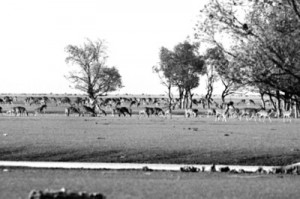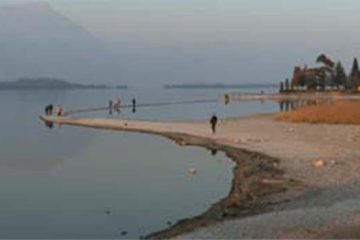Dr. Md. Mizanur Rahman
 NIJHUM is an offshore island in the Bay of Bengal, located in the extreme south of Hatia island separated by Hatia channel. It is a scenic treasure trove having 20 kms long sandy and grassy beach. Accredited on the estuarine Meghna river and the Bay of Bengal, Nijhum is a virgin island constituted of intertidal mudflats and sandflats. The island is dissected by small creeks or canals and its centre part is under cultivation and human habitation. It is a cluster of several small accreditation mainly Char Osman, Char Kamla, Char Muri and Ballar Char.
NIJHUM is an offshore island in the Bay of Bengal, located in the extreme south of Hatia island separated by Hatia channel. It is a scenic treasure trove having 20 kms long sandy and grassy beach. Accredited on the estuarine Meghna river and the Bay of Bengal, Nijhum is a virgin island constituted of intertidal mudflats and sandflats. The island is dissected by small creeks or canals and its centre part is under cultivation and human habitation. It is a cluster of several small accreditation mainly Char Osman, Char Kamla, Char Muri and Ballar Char.
It came under human settlement during 1969 and the Forest Department began aforestation in 1972 with mangrove species. Now it has a large deep green forest with native and early succesional tree species. This island was declared as a National Park in 2001 and now is one of the attractive tourist spots for its rich faunal and floral diversity. This island could be the next prime tourist spot after St. Martin’s island.
The most important type of tree planted in the island is Keora, also known as Kerfa, which has fast growing roots holding the sandy soil. Kakra, Gewa, Hargoza, Khalisha and Bain are the co-dominant species of this forest. There are several patches of Hogla (a robust herb) throughout the area. The main attraction in this successional mangrove forest is the herd of about 5000 spotted deer. The natural beauty has been enhanced by monkeys, wild boar, wild buffaloes, fishing cat, snakes, turtles, tortoises, Bengal monitor, black lizard, yellow monitor, oriental small-clawed otter, clawless otter and a huge number of migrated winter birds.
Tidal mudflats are very important habitats for water birds. Oysters of various nature and snails can be easily seen in this island. The water bodies are the ideal habitat for Hilsha fish, Zebra fish and Hamilton fish (Baila fish in local language). There is a large breeding colony of black-crowned night-heron, pond heron, grey heron, purple heron, cattle egret, little egret, lesser whistling-duck, bar-headed goose, cotton pygmy-goose, common shelduck, ruddy shelduck, tufted duck, water cock , and a wide variety of shorebirds, ring-billed gull, herring gull, noisy gull, sea terns, hawks, swallows, falcons, small cranes, local nightingales and king storks.
The environmental parameters with the direct influences on this island in terms of global climate change are sea-level rise, natural calamities like cyclones, rise in temperature and salinity. The species composition, natural regeneration, species richness, vertical and horizontal structure of this successional mangrove forest will undergo major changes under the predicted climate impacts. The World Wildlife Fund (WWF) has warned that within 60 years the mangrove forests will be inundated by the rising sea. The sea is rising more swiftly than the anticipation and may rise 11.2 inches by 2070. This would result in shrinkage of this island by 96% within half a century (WWF 2010).
A study has revealed that sea levels in the Bay of Bengal have risen much faster over the past decade. Recent satellite images show the New Moore Island or South Talpotti (the uninhabited territory south of the Hariabhanga river) has vanished due to sea rise. It is predicted that in the coming decade other islands in the Bay will follow South Talpotti beneath the waves (BBC, 24 March, 2010).
Sea level rise will cause a major threat to this successional mangrove ecosystem through sediment erosion, inundation stress and increased salinity landward. The predicted one-metre rise in sea level will destroy the whole ecosystem of this island. As sea level rises, the existing concentration of salinity and the distribution of freshwater in mangrove areas will be changed. The mangrove ecosystem will respond by changing in productivity, canopy closure, tree coverage and species diversity, or by migrating. Sea level rise will bring drastic changes in the livelihoods and socio-economic conditions of the inhabitants of these areas.
It is likely that their valuable arable land will be lost. Even a limited rise in sea level will seriously affect the people through loss of land; accelerated erosion along the coasts and in river mouths; increased salinity, changes in the physical characteristics of tidal rivers and increased vulnerability to flooding. Communities living in this island will be climatic refugees increasing pressure on the main land.
The frequency of occurring cyclones increased by 26% over past 120 years in the Bay of Bengal, which may be increased further with the intensifying of El Nino in the upcoming days. Aila caused a mass devastation on this island with two-three metres high surges sweeping over the whole area. A tidal surge of 15-20 feet inundated Nijhum Island during Sidr. These cyclones uproot, topple stems, break off trunks and defoliate the canopy. Sediments carried by storm surges are deposited on the forest floor as the surge recedes, cause plants mortality by interfering with root and soil gas exchange, leading to eventual death of the plants.
Storm surges weaken the potentiality of natural regeneration by reducing the viability of seeds, seedling germination and seedling recruitment. Invasive plant species likes lantana has the ability to rapidly colonize disturbed areas, and causes slower-growing of native plant species. The cyclone damages or alters structural diversity and spatial pattern of forests. The density of mortality (>5 cm diameter at breast height) ranges from 14-100% (depending on the intensity) and averages 47.7%. The reductions in total basal area range from 9-100%. Mortality increases by 9% during post-cyclone 7-18 months. Inter-specific differences in susceptibility to wind damage appear to be a primary factor contributing to spatial patterns in mortality (Sherman 2001).
With the increase of salinity the tree mortality rate will be accelerated as the production of new leaves, leaf longevity and the leaf area, net photosynthesis rate, stomata conductance and transpiration rate of leaves — all will be reduced. The deer, often in groups will come to the nearly locality by swimming rivers and canals to quench their thirst with sweet water. Many of the deer will die of drowning or caught by crocodiles and the people, or even bitten by dogs.
The breeding habitat of fishes likes Hilsha and other crustacean will be destroyed with the intrusion of salinity. They lay their eggs and stay up to juvenile stage in the freshwater. The leaves, stems, and roots of mangrove vegetations provide a vital shelter for predators and nourishment for young fish, shrimps, and crabs. Without this environment, only a handful would survive. Mangrove trees, a crucial component, provide shelter and nutrients to their ecosystems. They provide habitats to young fish, shrimps, crabs and mollusks. Hundreds of migratory bird species nest in mangrove forests.
Animals inhabit mangrove forests. The mangrove trees provide not only support to countless food webs; they are also indirectly responsible for the survival of the most primary planktonic and epiphytic algal food chains, which in turn provide carbon for the mangrove tree. Salinity is one of the most important factors of mangrove forest growth and distribution. 20-35% salt concentration is congenial for mangrove ecosystems. A salt concentration of 40-80% diminishes the number of species and their size and only a few species can exist and grow in 90% concentration (Hong 1993).
The mangrove ecosystem of Nijhum Island is a sustainable resource that provides huge number of people with food, tannins, fuel wood, timber, medicines and other ethno-botanical values. Mangrove offers protection of property and life from storms and coastal erosion. Sea level rise induced by global warming could alter substantially the status of mangrove forests, with serious consequences for coastal protection and resource management of this island.
Adaptive management can be effective to overcome the problems raised from climate change. Adaptation is often a traumatic process triggered by disaster rather than a gradual process of adjustment (Karas and Kelly 1993). However, the pragmatism of the people of Bangladesh in adapting to difficulties in the past with limited resources should prove of great value in the identification of appropriate adaptive responses. The nexus of pragmatism, education and community participation can provide an excellent base for efforts. The following measures could be taken to mitigate these problems:
o understanding the intrinsic links between climate change and impact;
o strong commitment of sustainable development at all levels of society; pushing forward research on climate change and preventive measures;
o controlling coastal ecosystems;
o framing a climate programme directed towards improving understanding of the global warming problem, monitoring of climate change and climate impacts, and the identification of appropriate responses;
o reducing greenhouse gas emissions by using hydropower and renewable sources to fulfil the demand of energy;
o designing and establishing sea-level / climate modelling network;
o restoring the nation’s forests and protecting the biodiversity which will not only reduce greenhouse gas emissions but could provide an enhanced sink;
o formulating a well-established strategy which will cope present-day climate-related disasters and the result of those disasters with the future impact of climate change;
o afforestation and reforestation by salt tolerant species;
o emphasising on the regional and wider international co-operation in scientific research;
o assessing accurate and more comprehensive data on the sources of greenhouse gases;
o establishing databases and information systems;
o developing alternative livelihoods for the people who are dependent on mangrove forest;
o examining different strategies to determine the extent to which their performance may be affected by climate change and sea level rise. Where possible, they must be “climate-proofed”;
o coastal vulnerability and risk assessment;
o emphasising on the protection, restoration and sustainable use of biological resources;
o integrated coastal and marine management;
o protecting existing mangroves against encroachment and cutting;
o facilitating natural regeneration and natural succession of native tree species;
o encouraging communication and co-ordination within and between relevant departments and institutions;
o raising funds for the conservation programme
o and developing coastal infrastructure;
o modifying the current organizational structures to facilitate reactions to climate change and sea level rise;
o establishing mechanisms to promote carbon uptake; and
o increasing social awareness and arm everyone with knowledge.
Dr. Md. Mizanur Rahman, a biodiversity specialist, is NDC, Jhalakathi Collectorate.
E-mail: mizan_peroj @yahoo.com



